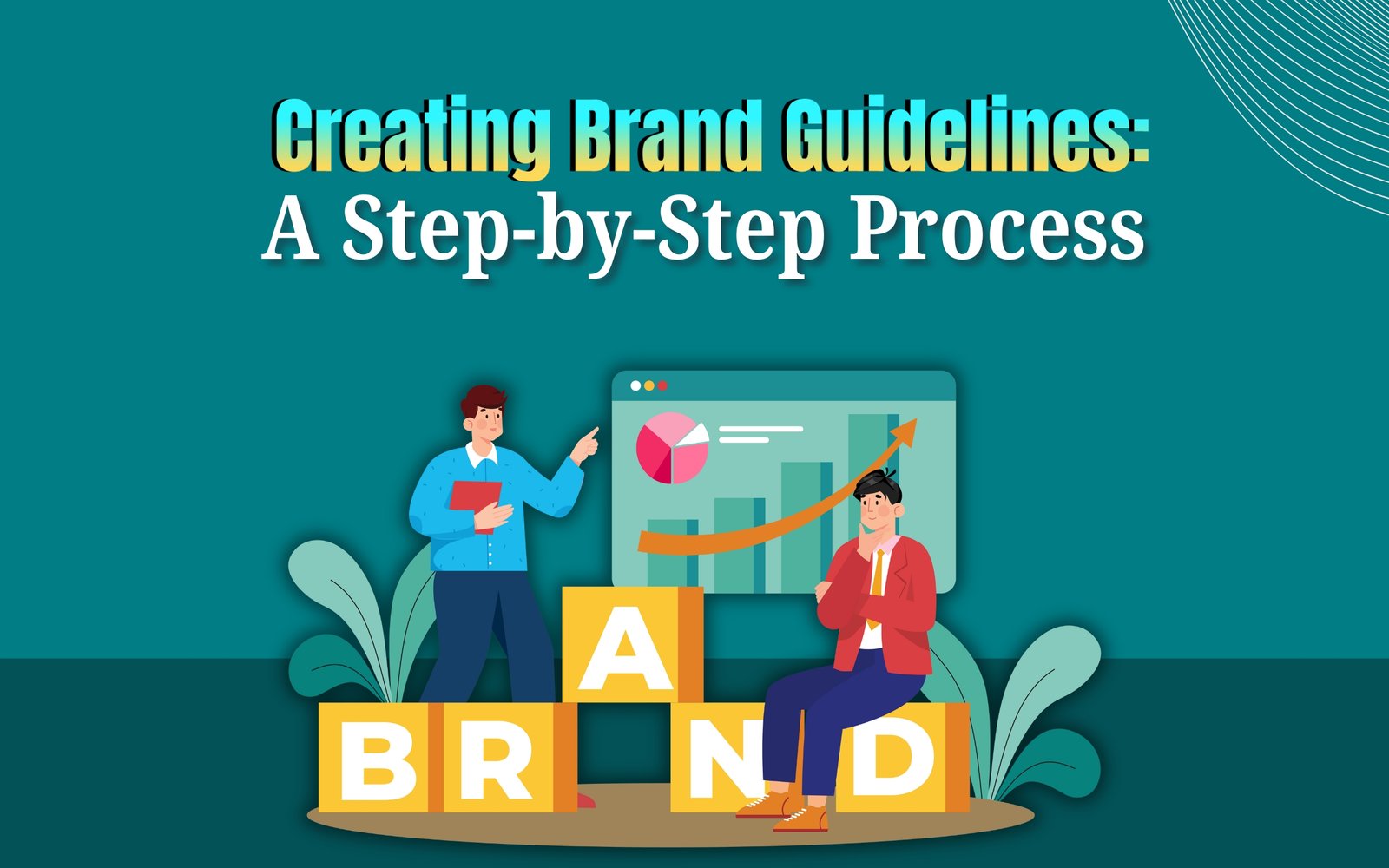Your brand is more than a logo or a color palette—it’s the full experience people have with you, online and offline. That’s why creating brand guidelines is one of the most important steps in building a recognizable, trustworthy business. When you invest time in creating brand guidelines, you’re building a practical playbook: how your brand looks, how it sounds, and how it should show up everywhere—from your website to your social media, ads, and emails. Let’s break down how to do it properly so your guidelines don’t end up as a beautiful PDF no one opens.
Why Brand Guidelines Matter
1. Consistency Builds Trust
When your website, social media, ads, and print materials all feel aligned, people subconsciously see you as more reliable and credible. Consistency is the foundation—you get that by creating brand guidelines and actually using them.
2. Faster Decisions, Fewer Arguments
Instead of debating fonts, colors, or headline styles on every project, your team can refer back to a clear document. Feedback shifts from “I don’t like this” to “This isn’t following our brand guidelines.”
3. Scalability as You Grow
When you start hiring designers, marketers, content creators, and agencies, your brand can’t live in one person’s head. Creating brand guidelines turns your brand into a scalable system that survives team changes.
4. Saves Time and Money
Clear, accessible rules mean fewer revisions, less confusion, and far less rework—which matters a lot if you’re paying by the hour.
What Brand Guidelines Include, and What They Don’t
Not every brand needs a 100-page manual. But good brand guidelines are focused, practical, and easy to follow.
What Brand Guidelines Include
- Brand Foundations
- Brand story, mission, vision
- Core values
- Positioning and target audience
- Brand promise or tagline
- Visual Identity
- Logo usage (primary, secondary, icon, spacing, “don’ts”)
- Color palette (with HEX, RGB, CMYK codes)
- Typography (font families, usage hierarchy)
- Imagery style (photography, illustrations, icons)
- Layout rules (grids, patterns, backgrounds)
- Verbal Identity
- Brand voice (how you sound)
- Tone guidelines for different contexts (website, social, support, legal)
- Messaging pillars (core themes you repeat)
- Sample copy (taglines, elevator pitch, example captions)
- Applications
- Website layouts and examples
- Social media templates
- Email designs
- Business cards, presentations, brochures
- Sample ad creatives
What Brand Guidelines Don’t Include
- Full marketing strategy or campaign plans
- Detailed ad budgets or media buying tactics
- Developer-level technical documentation (that belongs in a design system/dev doc)
- Every small internal preference that doesn’t affect the customer
Brand guidelines should stay focused on how the brand shows up, visually and verbally.
Prerequisites Before You Start
Before creating brand guidelines, get clear on a few strategic basics:
- Understand Your Audience
- Who are you talking to?
- What do they care about?
- What tone and style resonate with them?
- Clarify Your Positioning
- What makes you different from your competitors?
- Are you premium, affordable, innovative, traditional?
- How do you want people to describe you?
- Define Your Brand Personality
- Choose 3–5 traits (e.g., “friendly, confident, innovative”).
- These will guide both visuals and messaging.
- Audit Your Current Brand Assets
- Which elements already feel strong?
- Where are the biggest inconsistencies? (logos, fonts, tone, colors)
- List Key Brand Touchpoints
- Website
- Social media platforms
- Ads and landing pages
- Email campaigns
- Print materials and presentations
Your process for creating brand guidelines should be shaped by the channels you use the most.
Creating Brand Guidelines
This is where strategy turns into something tangible. Here’s a practical, step-by-step approach to creating brand guidelines that your team will actually follow.
Step 1: Define Your Brand Foundations
Start with short, clear statements:
- Mission – Why you exist
- Vision – Where you’re heading
- Values – What you stand for
- Positioning – Who you serve, what you offer, and why it’s different
These core statements act as your north star throughout the entire process of creating brand guidelines.
Step 2: Build Your Visual Identity
Work with a designer or brand specialist to lock in:
- Logo System
- Main logo + variations (horizontal, vertical, icon)
- Clear space and minimum size rules
- Background usage rules
- “Don’t do this” examples (stretching, wrong colors, busy backgrounds)
- Color Palette
- 2–3 primary colors
- 3–5 secondary/accent colors
- Color codes for digital and print
- Usage rules (what goes where, typical combinations)
- Typography
- Font choices for headings, body, and accents
- Sizes, weights, and hierarchy (H1–H6, paragraphs, buttons)
- Line spacing and alignment tips
- Imagery & Graphics
- Photography style (e.g., clean and bright, moody and cinematic)
- Illustration / icon style (flat, outlined, bold, minimal)
- Dos and don’ts for stock photos vs. custom visuals
Step 3: Shape Your Verbal Identity
This is the part that turns your brand into a recognizable voice.
- Define your brand voice in a few words
Example: “Friendly, expert, and straight-to-the-point. We avoid jargon and speak like a trusted advisor.”
- Clarify tone for different situations:
- Website homepage: confident and bold
- Blog: helpful and educational
- Support emails: calm and empathetic
- Legal pages: formal and precise
- Set messaging pillars:
- The core themes and claims that you want to repeat across channels (e.g., reliability, innovation, results, community).
- Include real samples:
- Example headlines
- Taglines
- Social captions
- CTA variations
When you’re creating brand guidelines, examples are more powerful than theory. They show your team exactly how to sound, not just what to avoid.
Step 4: Show Real-World Applications
Turn your rules into reality:
- Website mockups or screenshots using the new identity
- Social media tiles and story templates
- Email layouts with on-brand headlines and buttons
- Sample ads (Google, Meta, display)
- Presentation slides and proposal covers
This bridges the gap between “nice rules” and “this is how we actually apply them.”
Step 5: Document, Package, and Share
Once all pieces are ready:
- Organize everything into a clean, structured document (PDF or a web-based brand hub).
- Add a clear table of contents and easy navigation.
- Store it where everyone can find it (Drive, Notion, internal portal).
- Share it with designers, marketers, sales teams, support teams, and external partners.
Implementing Brand Guidelines Across Digital Channels
Once you’re done creating brand guidelines, the next challenge is actually using them everywhere.
Website
- Update logo, colors, and fonts to match the guide.
- Align headlines, CTAs, and body copy with your tone and messaging pillars.
- Standardize layouts for hero sections, service pages, and blog posts.
Social Media
- Use consistent templates and typography for posts and stories.
- Make sure your captions follow the brand voice and tone rules.
- Apply your color palette and image style so your feed looks cohesive.
Email Marketing
- Define a standard layout for newsletters and campaigns.
- Use branded buttons, headings, and signatures.
- Keep subject lines and body copy aligned with the tone guidelines.
Online Ads
- Ensure ad creatives follow your logo, color, and imagery rules.
- Reuse key phrases and CTAs defined in your messaging.
- Keep style consistent across platforms (Google, Meta, LinkedIn, etc.).
Other Digital Touchpoints
- Landing pages and funnels
- Webinars and slide decks
- Downloadable PDFs and lead magnets
- Chatbots and automated messages
Every touchpoint is an opportunity to reinforce your brand—or dilute it.
Measuring Impact and Maintaining Consistency
Brand consistency can and should be measured over time.
What to Track
- Engagement metrics
- Click-through rates, time on page, conversion rates before vs. after rollout
- Brand consistency audits
- Quarterly reviews of key pages and channels
- Team feedback
- Are designers and writers finding the guidelines helpful and clear?
- Production efficiency
- Fewer revisions and faster approvals after creating brand guidelines
Keeping Guidelines Alive
- Assign a brand owner or small team to approve key assets.
- Train new team members using the guidelines as part of onboarding.
- Review and update the document when you launch new services, change positioning, or refresh your identity.
Common Mistakes to Avoid
- Too Much Theory, Not Enough Practice
Endless mission/vision pages with no examples make guidelines unusable. - Overly Complicated Rules
If the rules are so strict that nobody can work efficiently, people will quietly ignore them. - Ignoring Voice and Tone
Visuals matter, but written communication is what people interact with every day. Don’t skip it. - No Stakeholder Involvement
If leadership, marketing, and sales aren’t aligned, you’ll struggle to enforce the guidelines. - Creating Brand Guidelines and Then Hiding Them
If no one can find the document, it might as well not exist.
Final Word
Creating brand guidelines is not just a design exercise—it’s a long-term strategy for controlling how your brand is perceived.
When your visuals, messaging, and tone are clearly defined and easy to follow:
- Your website looks more professional
- Your campaigns feel cohesive
- Your team works faster and more confidently
- Your audience recognizes and trusts you more
If your brand still lives in scattered files and random decisions, this is the right moment to start creating brand guidelines that bring everything together—and actually get used every day.
👉 Talk to us today and turn this process into real, practical brand guidelines that make design, content, and marketing easier for your entire team.










